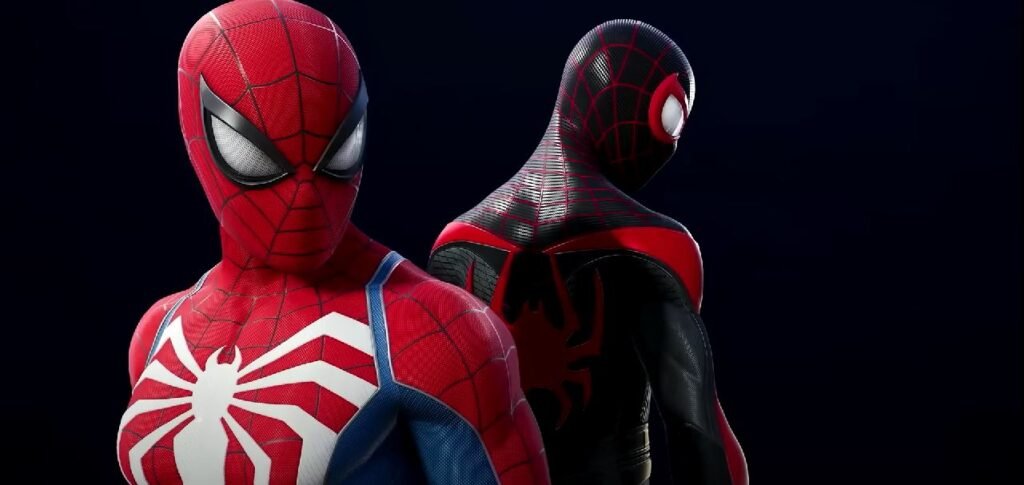It has felt like a very long wait for Sony and Insomniac Games to bring us the next installment of their White-Spider universe with Marvel’s Spider-Man 2, but the time has finally arrived as Peter Parker and Miles Morales both swing back into action as the playable Spider-Men in this follow-up to 2018’s Marvel’s Spider-Man and 2020’s Marvel’s Spider-Man Miles Morales.
I’m coming to this game as a big fan of the first two installments. Both have remained firmly installed on my system, whether for a quick blast of slick web-swinging and satisfying combat to blow off some steam or to enjoy their stories again in New Game + on ultimate difficulty. Both games are, in my opinion, masterful examples of how deeply satisfying movement, a straightforward but effective combat system, and well-performed emotional stories can make a new addition to the slightly tired open world “activate the towers and collect the things” genre a must play.
However, the first game had the misfortune of being released in a year when God of War had returned and blown everyone away. Similarly, Miles Morales, whilst doing perhaps an even better job of getting into its starring character’s head and the struggles he’s going through and making some excellent tweaks to combat and movement that both differentiate and improve on the first game, perhaps suffered from being marketed almost as DLC rather than its own game.
2023 is not exactly a forgiving year for Spider-Man 2 to release in, with juggernauts like Baldur’s Gate 3, Starfield, and The Legend of Zelda: Tears of the Kingdom already dominating the year. But on the Playstation-exclusive front, it’s got a more apparent runway. So, like its titular characters, does the new game do enough to live up to the legend of itself, its predecessors, and its competitors to come through?

Miles Morales flies into action over Manhattan’s Upper East Side
A quick note on spoilers: This review will be as spoiler-free as possible, but we will be discussing elements that have appeared in marketing materials like trailers and Playstation Showcase presentations.
All right, let’s do this one last time…
As you might expect, Spider-Man 2 is again set in Spider-Man’s traditional home turf of New York City, but it’s been expanded to include Peter and Miles’ even more traditional home turfs as the boys have now got the boroughs of Queens and Brooklyn to take care of too. In time-honored fashion, the game opens on an absolutely massive set piece that deftly sets up the stakes for both Peter and Miles.
In the broadest strokes, they’re struggling to find the balance between the responsibility of being Spider-Man and the necessity of living their regular lives alongside it. So far, so Spider-Man. Smartly, though, these Spider-Men are surrounded by a network of people who are fully aware of their double lives, which does away with the usual agonizing and hijinks trying to keep secret identities from those closest to our protagonists. Not that that’s a wrong angle to look at for superhero media, but it’s one we’ve seen plenty of already. And with that angle pretty much gone, we get to see our heroes operate with loving, caring support networks in place.
Peter and MJ are still together, living the younger millennial life of figuring out bills, mortgages, unstable working environments, and, trying to learn the balancing act of work, side gigs, and romantic relationships as the more carefree days of your teens and early twenties begin to disappear in the slipstream behind you.
Miles, our Gen-Z representative, is still living that relatively more carefree life as a 17-year-old, working on college applications, primarily excelling at school because he’s a genius and because his mum knows he’s Spider-Man so he takes the flack from his teachers and hanging with his friends who also know he’s Spider-Man. In fact, the comparative lack of friction between the two sides of Miles’ life is causing its own problem, in that Spider-Man is fast becoming all that he’s capable of seeing himself as.
It’s into this simmering tension that Peter and MJ’s best friend Harry Osborne returns from his gooey black treatment for a genetic disease, swiftly followed by big bad Sergei Kravinoff, aka Kraven the Hunter, a gigantic Russian billionaire with a gigantic fanatical militia, a gigantic pile of weaponry and tech, and a gigantic urge to hunt the most dangerous beings he can.
Put all that together, and you’ve got a Spider-Man story that might look familiar at a glance, but with a closer look, it’s got some essential differences that Insomniac’s White Spider universe is poised to delve into.

We feel you, Pete, things are getting a little heavy
Bring balance to New York
As the story goes, it’s a propulsive one that builds on the foundations laid so well in the first two games. The twists and turns that occur through the game are well worth experiencing fresh if you possibly can, so we won’t spoil them for you here. You know from the trailers that Harry Osborne is back and wants to reconnect with BFF Peter, that Kraven the Hunter is in New York, that Peter gets the iconic black suit, and that Venom is going to appear at some point. What you need to experience for yourself is how these variables are weaved together, what motivates the characters, and the other surprise character reveals that absolutely have not been in the marketing. Some of Spider-Man 2’s story might play out exactly as you expected, but it’s a credit to Insomniac that even the parts of the story that might feel predictable to a long time Spider-Fan look as though they could go in a myriad of different directions before the story beat commits. It keeps you on your toes.
There is a good amount of meaty drama to delve into for both Peter and Miles; Peter is still processing the loss of May in the first game, and Miles still carries the weight of losing both his father in the 2018 game and his surrogate sister Finn in his own. Both get main story missions that focus on their characters’ ongoing struggles in their lives, but it would be fair to say that this is more Peter’s story than Miles’. When you think about it, as soon as we saw the black suit on Peter in the extended gameplay, we should have figured that, but it was still a slight surprise that Miles seemed to take a bit of a back seat in terms of the more significant character motivated movements in the plot.
This is mediated somewhat by the game still having Miles as the playable character for a lot of the critical moments within the story, and Miles gets the lion’s share of the side content, which is also packed with beautiful, surprising moment stories, but really, this is Spider-Man 2, the sequel to the first game, and you can feel it.
Again, without spoilers, it’s hard to make the point, but the overall shape of Insomniac’s presumably 3 part Peter Parker story is pretty clear to see by the end of this game. Miles is a big part of that story and has his own journey to go on too, but this is about Peter Parker, his iconic villains, and how he and they have shaped and created each other respectively.
The game is fantastically performed and captured by the entire main cast. Scenes feel more effortlessly intimate compared to the previous games, far more nuanced in small moments of physical and facial performance, and the story is gripping enough that, when presented with the following primary mission marker, the pull to head straight there and see what happens next is overwhelming. This can have the adverse effect of throwing you into some of the more challenging fights in the later game without having access to as many of your moves and abilities as you would if you meticulously tick off the side content before moving on through the story, but even playing on the hardest difficulty, nothing feels insurmountable. Well, some of the later boss fights may have had me itching to bump the difficulty down a notch, but as I loved the puzzle and challenge of the gameplay, I stuck with it. So, speaking of gameplay…
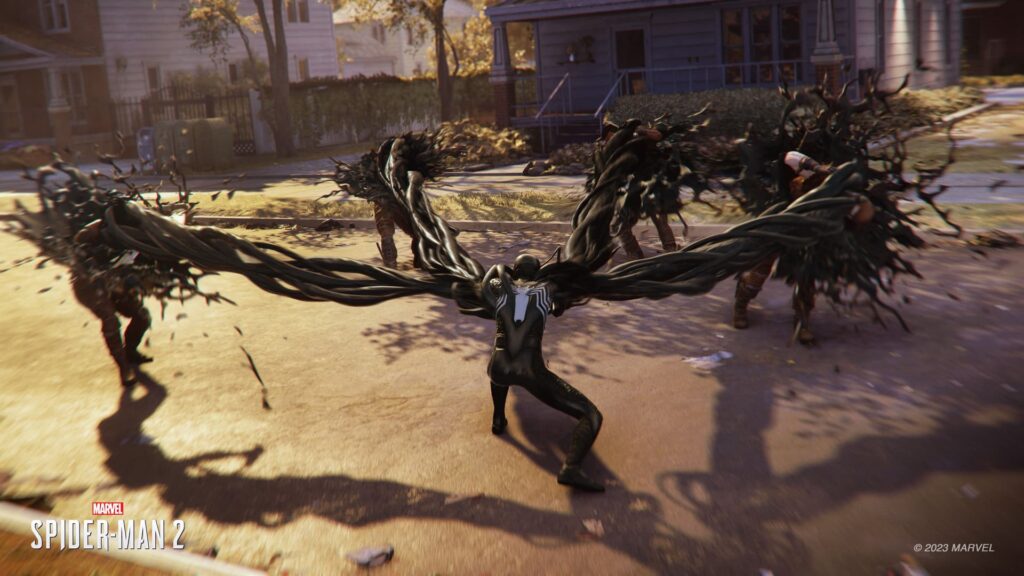
Peter demonstrates some of his new black suit abilities
Mechanical Complexity
Broadly speaking, if you had fun with the combat and traversal of the previous games, you’ll feel pretty well right at home here with Spider-Man 2. If you want to drop into a big group of bad guys, the series staples of dodging, punching, webbing, and air combat are all present and correct. Likewise, web swinging and point launching work precisely as they did in the previous games. But Insomniac has been busy streamlining and tweaking, and making some intelligent additions that add depth, interest, and challenge to the main verbs of the game.
In combat, new options for crowd control encourage you to change up your strategies and require a more tactical approach, even on lower difficulties. Many ranged enemies now have a great deal of added mobility, zipping between elevated positions and doing their best to stay at range from you, peppering you with gunfire and explosives. As well as these additions encouraging a change in play style, there is also the new parry mechanic. In general combat, a melee attack can now be parried with a press of L1 just as the spider-sense indicator warning of an incoming attack turns red. Rather than just dodging this attack, the attacking enemy and possibly others around them are knocked back, and as your abilities are upgraded, you’re given even more options with how to follow up this riskier but more rewarding option.
Another incentive to move away from just smashing the circle button whenever the spider-sense indicator lights up is the new combination of un-dodgeable and un-parryable attacks. Enemies in Spider-Man 2 will charge in for a heavy attack. If their attack lights up yellow as it’s coming in, it has to be parried as it turns red; a dodge here leaves you open for massive damage. Likewise, dodging is your only option if it’s blue on the way in. As it’s often the most significant, meanest bad guys using these attacks, it can really mess up your day if you get one wrong while surrounded by a crowd of other enemies. All of this adds up to a combat system that might look familiar on the surface but requires a great deal more attentiveness and precision to master, even on lower difficulties. Another combat change is welcome compared to the previous games: bosses now have health bars. Some of these guys hit like trucks and can be viciously fast, so having that visual indication helps with the balancing act of deciding whether to use your precious focus bars to heal before you take a fatal hit or whether to push on and use it for a finisher attack for massive damage that might push them over the edge.
In the same way as the combat, traversal is built on the same building blocks as the previous games. However, the addition of the web wings adds a whole new dimension to getting across the sizeable map. I was concerned that the web wings would make the other options like swinging, wall running, and point zipping feel obsolete, but thankfully, they’re a smartly balanced mechanic. If you’re perched atop the Empire State Building or Avengers Tower, the web wings allow you to cover more ground from the get-go, rather than requiring a long dive down to the ground to find somewhere to swing from. However, outside of the wind tunnels, which are there specifically to boost you along some of the more prominent thoroughfares and across the rivers, the web wings can be a little slow and twitchy… but in a good way. It keeps the wings as just another part of your arsenal, gliding across a gap before finding another point to zip to, diving down into a swing to shoot you forward… it’s just great.
And, for people who grew up on the other Spider-Man 2, I.e., the PS2 game of the Toby Maguire movie, there is now the ability to adjust how much the game assists in your web swinging. Want it to be smooth and frictionless, getting you from A to B in style without worries? Whack the swinging assist up to max, and you’re golden. But if you want to add more feedback to your web-swinging, if you want to feel like you’ve got to work to bend the web where you need it to go, and maybe get punished for trying to swing somewhere that’s too low or too dense with obstacles, then turn it all the way off and live that complete physics-based swinging life you might remember from the PS2/GameCube. For me, I turned it all the way off. It certainly added a few annoying moments in chases where I struggled to get the height to swing when I needed it, but it forced me to embrace all the other traversal options and mechanics. Also, the ability to carry NPCs to the hospital when they’re injured is another little nod to its namesake. Sadly, there is no collecting escaped balloons for small children or pizzas to deliver, but we can’t have everything now.
But these new abilities and options aren’t available from the beginning. As with the previous two games, you’ll be upgrading a number of different sets of skills, abilities, gadgets, and passive suit buffs for health, damage, focus, and traversal. These upgrades use the various tokens that are given for completing missions, side missions, and finding collectibles through the city, giving the open-world collectathon more purpose and incentive if the extraordinary little stories and snippets of mysteries that you find as you complete side content aren’t enough to have you looking for them already.
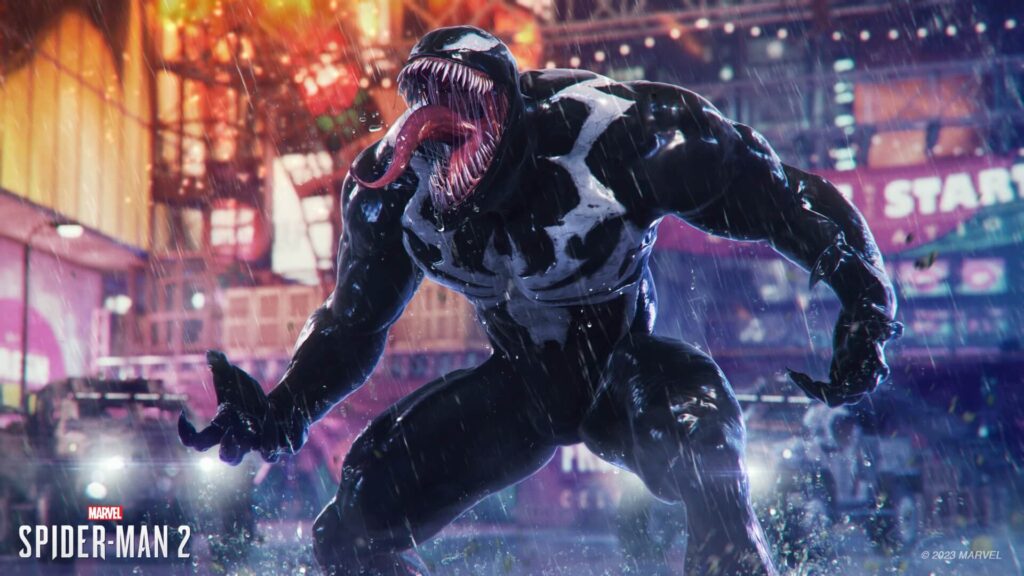
Venom shows everyone his… iconic appendage
With great power, comes great gaming
On the technical front, Spider-Man 2 has made the significant leaps that you would expect. Fully leveraging the power of the PS5 without needing to make concessions for last-gen consoles allows for ray tracing features in both the fidelity and performance modes. Fidelity locks the game at 30fps but increases the image quality, mostly in shadow and reflection detail and pedestrian and traffic density. The 60fps performance mode still keeps some ray-traced reflections, but they’re of a lower quality or are entirely missing from smaller objects in the environment. It has to be pointed out that during gameplay, these limitations are much less noticeable, but if you’re a photo mode fanatic and you want it the absolute best it can possibly look, fidelity mode has some advantages.
If you’re lucky enough to have access to a VRR and/or 120Hz display enabled, you get some further options. VRR has the default ‘smoothed’ option that smooths out any variations in framerate, which are few and far between. And with 120Hz enabled, Fidelity mode instead targets 40fps, finding a decent middle ground between the buttery smooth 60fps for performance but giving you those extra levels of details that take the game from looking amazing to looking spectacular.
Graphically Spider-Man 2 looks fantastic. Character models are more detailed, hair animation is improved, and the level of detail in the world is far higher than in the previous games, with New York looking dense and solid out to a far greater distance than the previous two titles. Being a sizeable open-world game, you’re still not going to be getting the same level of detail as something like The Last of Us Part 1, but it’s still a fantastic-looking game all the same.
The game also makes excellent use of Sony’s 3D audio tech. Playing with the Pulse 3D headset adds another level of immersion to the world, allowing you to pinpoint sounds directionally, helping in combat and general exploration. The sound design itself is similarly stellar; the magnificent score is always well highlighted without becoming overbearing, all of the Spider-Sounds fit right in, and particularly when using Peter’s black suit abilities, combat gets a resounding, bassy, visceral hit.
The Dualsense controller also shows its worth in terms of immersion, with the combination of haptic feedback and adaptive triggers subtly augmenting the experience in just the right ways. Peter’s Black Suit abilities feel extremely powerful, and the intelligent use of the triggers in puzzle design and traversal adds another subtle layer. The moment that I realized that the right trigger adds more resistance when you swing out of a high-speed dive, pushing the idea that you’re really having to fight to hang on against the immense centrifugal forces at play, gave me a visceral thrill.
I do have to be balanced here, though, and note that the experience has not been without technical issues. In my playthrough of the game, I had four hard crashes to the PlayStation dashboard, a number of visual and audio bugs like subtitles not matching the audio, or the occasional NPC floating 5 feet above the ground. There were also two moments where the game stopped registering a particular input button during side content exploration sequences, which necessitated restarting a checkpoint to rectify. It’s a surprise, given that I have never had any of these issues with either of the previous games, but given the size and scope of the game, a few checkpoint resets or restarts from the main menu aren’t too out of the ordinary, and will hopefully be dealt with by patches over the next few weeks and months.
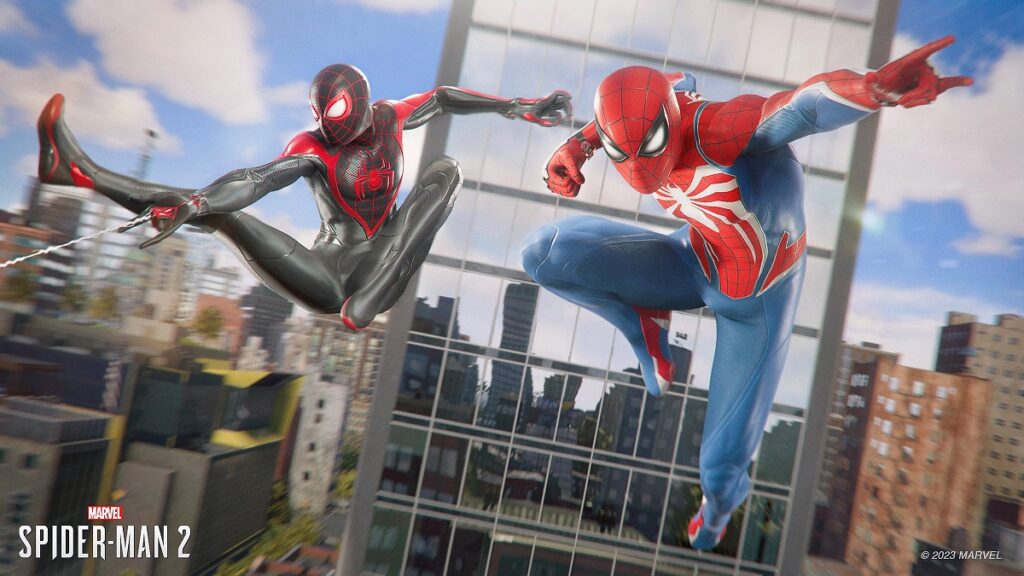
Swinging back into action
Overall, an entire completionist run of the game on spectacular difficulty, unlocking the platinum, and a few hours of extra time just swinging around fighting crime and messing with photo mode has taken me 27 hours, although it doesn’t feel like a more minor game than 2018’s offering. There is side content galore. The main story is dense and weighty, with a wide variety of one-off set pieces and moments that don’t appear anywhere else in the game. You might be able to clear it faster than Spider-Man 2018, but that feels in large part down to the impressive improvements in traversal speed around the city. Analysis has shown that you can move through the city fully three times faster in Spider-Man 2, not to mention that if you do decide to fast travel, it’s instantaneous here. It may take less time overall, but that is less time waiting on loading screens as you wait to ‘fast travel’ from the Financial District to Harlem. It’s all killer, no filler.
Spider-Man 2 also offers a magnificent array of accessibility and customization options. You can simplify puzzles, autocomplete QTEs, simplify chase sequences, customize enemy damage and health, and increase the notification length for perfect parries and dodges. You can make everyone in the game a glass cannon, set enemy damage to ultimate but health to friendly neighbourhood, and a street thug with a crowbar can take you out in two hits, but you can do the same to him and his crew. And these settings can be adjusted at any time, without impacting trophies or completion stats. It’s another welcome addition that lets people play however best suits them. If you’re a complete maniac, you can set the whole thing to Ultimate and have an edge-of-your-seat ride. If you want the story, Friendly Neighbourhood difficulty will never let you get knocked out in combat, and you as the player can set that level to exactly where you feel happiest.
On the question of replayability, then, mileage will vary. At launch, Spider-Man 2 doesn’t have a New Game Plus mode, although it is expected by the end of 2023. It also hasn’t launched with the intelligent addition from Miles Morales, which allowed you to replay story and side missions from within your current save, although that is coming too. At present, if you’ve finished the game, you unlock the option to play at Ultimate difficulty, either from a brand new save or in your existing one. I found the story and gameplay so affecting that, even though I’d prefer it to be New Game Plus, I’ve already loaded back in with a new run because I want to do that boss fights all over again. And we can still hope that there might be some DLC planned down the line in the vein of 2018’s City that Never Sleeps set of three expansions, but at present, there’s no word on that either way.
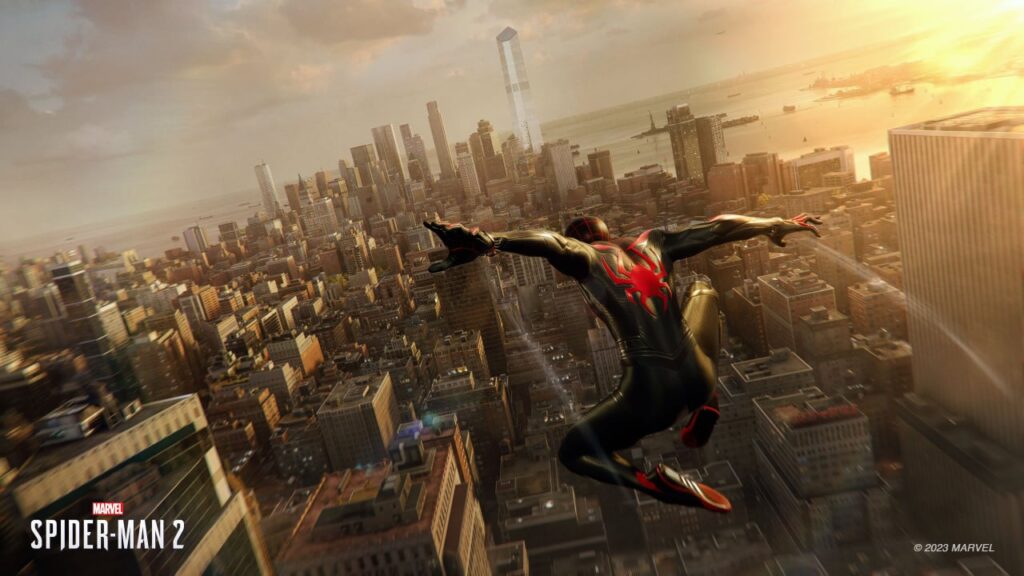
Miles leaps towards the Manhattan skyline
The Verdict
Marvel’s Spider-Man 2 takes the familiar formula of the previous two games and refines it even further. Combat has added depth, traversal adds the web wings to an already masterful toolkit, and these mechanics carry the player through a dark, complex, and personal story about the pressures of balancing all the varying parts of life in the modern world: work, rent, relationships both romantic and plutonic. The added flexibility in the robust accessibility and difficulty options means that the game can be perfectly tailored to deliver the precise experience that most given players could be looking for. Insomniac and Sony have made each discreet part of the game good enough to be worth playing alone, and when added together, have given us what is undoubtedly the pinnacle of what’s possible with a Spider-Man game so far.
Joys
- Brilliantly performed and engaging story
- Smart tweaks and additions to combat and traversal
- Accessibility and customisation options are amazing
Cons
- More bugs at launch than the previous entries in the series
- NG+ and mission replays not available on day one
